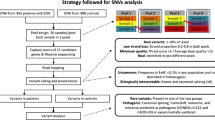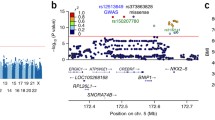Abstract
Chibby (CBY) has been identified as a potent proadipogenic factor required for adipocyte differentiation. It has been shown that CBY inhibits the canonical Wnt pathway, and therefore promotes the development of new fat cells. Our objective therefore is to investigate the contribution of rare and common genetic variation in CBY to the development of human obesity. A mutation analysis was performed on a total of 566 obese patients and 432 lean individuals. To investigate the involvement of CBY in complex obesity, we performed a genetic association analysis of the entire CBY gene region on 1,011 obese individuals and 523 control samples. Four rare, novel variants were identified in either obese patients or lean control subjects, among which two non-synonymous variations and one frameshift mutation. In addition, four previously reported CBY variants were found. In the association analysis, logistic and linear regression showed no association between common genetic variation in CBY and obesity parameters. Several novel variations were found, but no definite role in the pathogenesis of obesity could be confirmed. Results from the association analysis suggest that common variation in CBY is not a cause for obesity in the Belgian population.

Similar content being viewed by others
References
Van Gaal LF, Mertens IL, de Block CE (2006) Mechanisms linking obesity with cardiovascular disease. Nature 444(7121):875–880. doi:10.1038/nature05487
World Health Organisation (2011) Obesity and overweight_fact sheet N°311. http://www.who.int/mediacentre/factsheets/fs311/en/. Accessed 28 March 2011
Bhanot P, Brink M, Samos CH, Hsieh JC, Wang Y, Macke JP, Andrew D, Nathans J, Nusse R (1996) A new member of the frizzled family from Drosophila functions as a Wingless receptor. Nature 382(6588):225–230. doi:10.1038/382225a0
Papkoff J, Aikawa M (1998) WNT-1 and HGF regulate GSK3 beta activity and beta-catenin signaling in mammary epithelial cells. Biochem Biophys Res Commun 247(3):851–858. doi:10.1006/bbrc.1998.8888
Papkoff J, Rubinfeld B, Schryver B, Polakis P (1996) Wnt-1 regulates free pools of catenins and stabilizes APC-catenin complexes. Mol Cell Biol 16(5):2128–2134
Bejsovec A (2000) Wnt signaling: an embarrassment of receptors. Curr Biol 10(24):R919–R922
Archbold HC, Yang YX, Chen L, Cadigan KM (2011) How do they do Wnt they do? regulation of transcription by the Wnt/beta-catenin pathway. Acta Physiol (Oxf) 204(1):74–109. doi:10.1111/j.1748-1716.2011.02293.x
Kang S, Bennett CN, Gerin I, Rapp LA, Hankenson KD, Macdougald OA (2007) Wnt signaling stimulates osteoblastogenesis of mesenchymal precursors by suppressing CCAAT/enhancer-binding protein alpha and peroxisome proliferator-activated receptor gamma. J Biol Chem 282(19):14515–14524. doi:10.1074/jbc.M700030200
Kawai M, Mushiake S, Bessho K, Murakami M, Namba N, Kokubu C, Michigami T, Ozono K (2007) Wnt/Lrp/beta-catenin signaling suppresses adipogenesis by inhibiting mutual activation of PPARgamma and C/EBPalpha. Biochem Biophys Res Commun 363(2):276–282. doi:10.1016/j.bbrc.2007.08.088
Bennett CN, Ross SE, Longo KA, Bajnok L, Hemati N, Johnson KW, Harrison SD, MacDougald OA (2002) Regulation of Wnt signaling during adipogenesis. J Biol Chem 277(34):30998–31004. doi:10.1074/jbc.M204527200
Ross SE, Hemati N, Longo KA, Bennett CN, Lucas PC, Erickson RL, MacDougald OA (2000) Inhibition of adipogenesis by Wnt signaling. Science 289(5481):950–953
Longo KA, Wright WS, Kang S, Gerin I, Chiang SH, Lucas PC, Opp MR, MacDougald OA (2004) Wnt10b inhibits development of white and brown adipose tissues. J Biol Chem 279(34):35503–35509. doi:10.1074/jbc.M402937200
Shen L, Glowacki J, Zhou S (2011) Inhibition of adipocytogenesis by canonical WNT signaling in human mesenchymal stem cells. Exp Cell Res 317(13):1796–1803. doi:10.1016/j.yexcr.2011.05.018
Takemaru K, Yamaguchi S, Lee YS, Zhang Y, Carthew RW, Moon RT (2003) Chibby, a nuclear beta-catenin-associated antagonist of the Wnt/Wingless pathway. Nature 422(6934):905–909. doi:10.1038/nature01570
Mokhtarzada S, Yu C, Brickenden A, Choy WY (2010) Structural characterization of partially disordered human Chibby: insights into its function in the Wnt-signaling pathway. Biochemistry 50(5):715–726. doi:10.1021/bi101236z
Mofunanya A, Li FQ, Hsieh JC, Takemaru K (2009) Chibby forms a homodimer through a heptad repeat of leucine residues in its C-terminal coiled-coil motif. BMC Mol Biol 10:41. doi:10.1186/1471-2199-10-41
Li FQ, Mofunanya A, Harris K, Takemaru K (2008) Chibby cooperates with 14–3-3 to regulate beta-catenin subcellular distribution and signaling activity. J Cell Biol 181(7):1141–1154. doi:10.1083/jcb.200709091
Li FQ, Mofunanya A, Fischer V, Hall J, Takemaru K (2009) Nuclear-cytoplasmic shuttling of Chibby controls beta-catenin signaling. Mol Biol Cell 21(2):311–322. doi:10.1091/mbc.E09-05-0437
Takemaru K, Fischer V, Li FQ (2009) Fine-tuning of nuclear-catenin by Chibby and 14–3-3. Cell Cycle 8(2):210–213
Li FQ, Singh AM, Mofunanya A, Love D, Terada N, Moon RT, Takemaru K (2007) Chibby promotes adipocyte differentiation through inhibition of beta-catenin signaling. Mol Cell Biol 27(12):4347–4354. doi:10.1128/MCB.01640-06
Voronina VA, Takemaru K, Treuting P, Love D, Grubb BR, Hajjar AM, Adams A, Li FQ, Moon RT (2009) Inactivation of Chibby affects function of motile airway cilia. J Cell Biol 185(2):225–233. doi:10.1083/jcb.200809144
Love D, Li FQ, Burke MC, Cyge B, Ohmitsu M, Cabello J, Larson JE, Brody SL, Cohen JC, Takemaru K (2010) Altered lung morphogenesis, epithelial cell differentiation and mechanics in mice deficient in the Wnt/beta-catenin antagonist Chibby. PLoS One 5(10):e13600. doi:10.1371/journal.pone.0013600
Roelants M, Hauspie R, Hoppenbrouwers K (2009) References for growth and pubertal development from birth to 21 years in Flanders, Belgium. Ann Hum Biol 36(6):680–694. doi:10.3109/03014460903049074
van der Kooy K, Seidell JC (1993) Techniques for the measurement of visceral fat: a practical guide. Int J Obes Relat Metab Disord 17(4):187–196
Lukaski HC, Johnson PE, Bolonchuk WW, Lykken GI (1985) Assessment of fat-free mass using bioelectrical impedance measurements of the human body. Am J Clin Nutr 41(4):810–817
Deurenberg P, Weststrate JA, Hautvast JG (1989) Changes in fat-free mass during weight loss measured by bioelectrical impedance and by densitometry. Am J Clin Nutr 49(1):33–36
Miller SA, Dykes DD, Polesky HF (1988) A simple salting out procedure for extracting DNA from human nucleated cells. Nucleic Acids Res 16(3):1215
Ng PC, Henikoff S (2001) Predicting deleterious amino acid substitutions. Genome Res 11(5):863–874. doi:10.1101/gr.176601
Adzhubei IA, Schmidt S, Peshkin L, Ramensky VE, Gerasimova A, Bork P, Kondrashov AS, Sunyaev SR (2010) A method and server for predicting damaging missense mutations. Nat Methods 7(4):248–249. doi:10.1038/nmeth0410-248
Li B, Krishnan VG, Mort ME, Xin F, Kamati KK, Cooper DN, Mooney SD, Radivojac P (2009) Automated inference of molecular mechanisms of disease from amino acid substitutions. Bioinformatics 25(21):2744–2750. doi:10.1093/bioinformatics/btp528
Sigrist CJ, Cerutti L, de Castro E, Langendijk-Genevaux PS, Bulliard V, Bairoch A, Hulo N (2010) PROSITE, a protein domain database for functional characterization and annotation. Nucleic Acids Res 38 (Database issue):D161–166. doi:10.1093/nar/gkp885
Goldenberg O, Erez E, Nimrod G, Ben-Tal N (2009) The ConSurf-DB: pre-calculated evolutionary conservation profiles of protein structures. Nucleic Acids Res 37 (Database issue):D323–327. doi:10.1093/nar/gkn822
Calabrese R, Capriotti E, Fariselli P, Martelli PL, Casadio R (2009) Functional annotations improve the predictive score of human disease-related mutations in proteins. Hum Mutat 30(8):1237–1244. doi:10.1002/humu.21047
International HapMap Consortium (2003) The International HapMap Project. Nature 426(6968):789–796. doi:10.1038/nature02168
de Bakker PI, Yelensky R, Pe’er I, Gabriel SB, Daly MJ, Altshuler D (2005) Efficiency and power in genetic association studies. Nat Genet 37(11):1217–1223. doi:10.1038/ng1669
Ott J (2011) Documentation to LINKAGE UTILITY programs. http://linkage.rockefeller.edu/ott/linkutil.htm. Accessed 10 Feb 2011
Gauderman W, Morrison J (2009) Gene x Environment, Gene x Gene Interaction Home page. http://hydra.usc.edu/gxe/. Accessed 10 Feb 2011
Hidaka S, Konecke V, Osten L, Witzgall R (2004) PIGEA-14, a novel coiled-coil protein affecting the intracellular distribution of polycystin-2. J Biol Chem 279(33):35009–35016. doi:10.1074/jbc.M314206200
Acknowledgments
This study was supported by a TOP-research grant from the University of Antwerp to WVH. The study was also funded by a PhD grant of the Institute for the Promotion of Innovation through Science and Technology in Flanders (IWT-Vlaanderen) to DZ. SB holds a postdoctoral fellowship obtained from the Flemish Fund for Scientific Research (F.W.O. Vlaanderen).
Conflict of interest
The authors declare that they have no conflict of interest.
Author information
Authors and Affiliations
Corresponding author
Rights and permissions
About this article
Cite this article
Van Camp, J.K., Zegers, D., Verhulst, S.L. et al. No important role for genetic variation in the Chibby gene in monogenic and complex obesity. Mol Biol Rep 40, 4491–4498 (2013). https://doi.org/10.1007/s11033-013-2541-3
Received:
Accepted:
Published:
Issue Date:
DOI: https://doi.org/10.1007/s11033-013-2541-3




